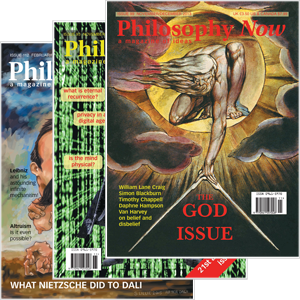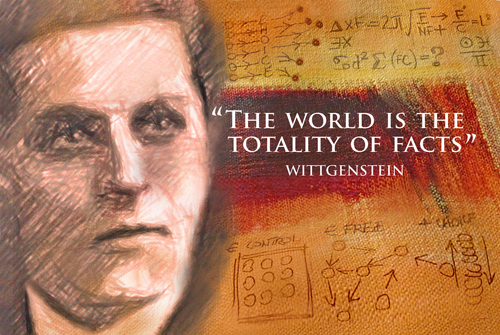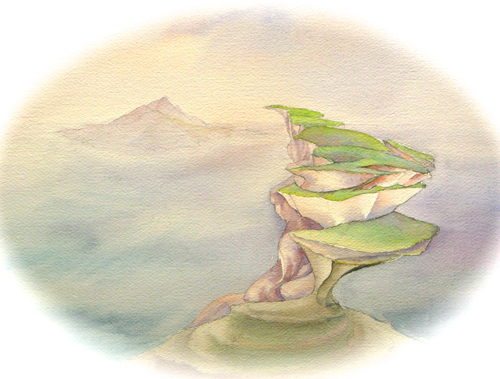
Your complimentary articles
You’ve read one of your four complimentary articles for this month.
You can read four articles free per month. To have complete access to the thousands of philosophy articles on this site, please
Sources of Knowledge
Gödel, Wittgenstein, & the Limits of Knowledge
Michael D. McGranahan takes us to the edge of language, mathematics and science.
There are things we can never know. There are questions that have no answer. There will always be uncertainty.
People typically reject these notions. We like to think we can delve into any problem and eventually find the solution, examine any mystery and uncover the truth. But this just isn’t so. There are limits to what we can know about the world. Here I want to explore the convergence of Gödel and Wittgenstein on the limits of knowledge, against a background of Russell, Hilbert, and Heisenberg. We will find that mathematics, logic, and science all lead to the same truth: that not everything is knowable.

Image © Miles Walker 2025 Please visit mileswalker.com
What Can We Know?
Reality is like an image in a cloud. From a distance, things seem clear: surely that’s a rabbit. But move closer and the shape distorts: it looks less and less like a rabbit. Closer still, and the image becomes fuzzier and fuzzier, until eventually it’s a blur. Finally, you’re swallowed up in fog and nothing makes sense. Why is that? Why does a close examination of reality only yield more questions?
Let’s turn back the clock about a hundred years to Kurt Gödel (1906-78) and Ludwig Wittgenstein (1889-1951). It is striking that over a century later we’re still grappling with their insights. Let me say at the outset that these thinkers were dealing with difficult concepts, but we won’t be delving into the gritty details. Instead I’ll summarize their ideas, distilling down to the essential results, and leave it to the curious reader to investigate the details.
We start with Wittgenstein. He fought in WWI, was captured, and while in a prisoner of war camp wrote up the notes that he had scribbled in the trenches. This became his Tractatus Logico-Philosophicus, and was published after the war, in 1921, at the instigation of his friend Bertrand Russell. The book centres around the question, what are the limits of world, thought, and language? When he’d finished writing it, Wittgenstein was convinced he had solved all philosophical problems (he was a confident fellow).
Here is Wittgenstein’s basic approach in the Tractatus: The world consists not of objects, but of facts. Facts are states of affairs, both actual and possible, with the actual comprising the world. We can make logical pictures of facts, which we call thoughts, and these thoughts when written down are propositions. A sentence about the world – a proposition – creates a picture of the world, and the proposition is true if the picture corresponds to the facts. These language pictures were a crucial and innovative concept: they consist of elements, and each element represents an object, or part of an idea. You put the elements together to form propositions (sentences). Descriptions of the world arise out of propositions, and these can be either true or false. True propositions agree with reality, false ones do not. Here are some ideas from the Tractatus about knowledge:
1. “The book will… draw a limit to… the expression of thoughts; for in order to draw a limit to thinking we should have to be able to think both sides of the limit.” (Preface). Here Wittgenstein observes that to think both sides of this ‘limit’ to thought, we would have to think what cannot be thought, which is impossible. Therefore…
2. The limit can “only be drawn in language and what lies on the other side of the limit will simply be nonsense” (Preface).
3. Later, Wittgenstein observes that “The limits of my language mean the limits of my world” (5.6).
4. “Propositions can represent the whole reality, but they cannot represent” the logical form of their own nature. “To be able to represent the logical form, we should have to be able to put ourselves with the propositions outside logic, that is outside the world” (4.12).
5. Accordingly, “That which expresses itself in language, we cannot express by language” (4.121).
6. Finally, “What can be said at all can be said clearly; and whereof one cannot speak, thereof one must be silent” (Preface). This presages the book’s famous final proposition: “Whereof one cannot speak, thereof one must be silent” (7.0).
In between these ideas are a great many details, propositions, and arguments, and considerable confusion. We will come back to Wittgenstein in a minute, but first, Gödel.
Gödel
Kurt Gödel published his remarkable (that is, shocking) Incompleteness Theorems in 1929. Ernest Nagel and James Newman, in their book Gödel’s Proof (2005), say that incompleteness “has not been fully fathomed” – and this is still true today. Incompleteness is deep and esoteric; and yet it reveals simple, profound insights.
Gödel’s investigation harkens back to the Principia Mathematica, the magnum opus of Bertrand Russell and Alfred North Whitehead published between 1910 and 1913. In it, among other things, Russell and Whitehead attempted to solve the paradoxes that plagued mathematics, with an aim to establishing a solid foundational system for all of mathematics. Following Russell and Whitehead, the mathematician David Hilbert (1862-1943) went a step further to propose a type of the mathematical system specified in the Principia Mathematica – one which contained no contradictions and was also complete – meaning, every true mathematical statement could be derived from within the system. These philosopher-mathematicians, Russell, Whitehead, and Hilbert, sparked many investigations, including Gödel’s. He hoped to prove the completeness of mathematics, but ended up doing the opposite.
But first, a few definitions:
Formal System: A system of logical axioms equipped with rules of inference. An axiom is a self-evident truth that requires no proof (it’s a universally accepted rule).
Consistency: A formal system is consistent if there is no statement such that the statement itself and its negation are both derivable from it. That is, there are no contradictions.
Completeness: A formal system is complete if for every statement within the language of the system, either the statement, or its negation, can be derived (that is, proved) by the system. More simply, in a complete system, every true statement is provable.
The first two definitions are obvious: you must begin with a system, and no one would start with an inconsistent system that has built-in contradictions. The question, then, is about the completeness of such systems.
Gödel’s First Incompleteness Theorem proves mathematically that any consistent formal mathematical system within which a certain amount of elementary arithmetic can be carried out, is incomplete – meaning, there are one or more true statements that can be made in the language of the system which can neither be proved nor disproved in the system. This finding leads to two alternatives: Alternative #1: If a set of axioms is consistent, then it is incomplete. Alternative #2: In a consistent system, not every true statement can be proved in the language of the system. Notice the possibility of many true statements being provable – just not all true statements: at least one statement will be unprovable.
Gödel’s Second Incompleteness Theorem is simply this: No set of axioms can prove its own consistency.
With the First and Second Incompleteness Theorems, Gödel effectively ended the search for a consistent and complete mathematical system. It logically cannot exist. As John von Neumann told Gödel, “your result has solved negatively the question: there is no rigorous justification for classical mathematics” (Collected Works V.S. Feferman, et al, 2003, p.339).
Referring to the First Incompleteness Theorem definition above, with particular attention to “one or more true statements… which can neither be proved nor disproved…”, let me present a back-of-the-napkin ‘demonstration’ of the plausibility of the idea, as follows. The inclusion of a Liar’s Paradox (e.g. ‘This sentence is false’) does not render a system of ideas inconsistent. Rather, the paradox cannot be proved. Therefore you now have a consistent system with at least one true statement that is unprovable. The system, then, is incomplete.
Granted, this ‘demonstration’ is fast and loose. However, it is this sort of epiphany that led Gödel to his rigorous proof. He began by transforming the paradox into a metamathematical statement, which he then ingeniously mathematized, to use it to prove mathematically that not everything in mathematics is provable. So knowing something is true, and proving it, are two different things.
Wittgenstein, Gödel, & Russell
Perhaps you can see why I started with Wittgenstein. His propositions 4 and 5 above overlap somewhat with Gödel’s findings.
Bertrand Russell – yes, the same Bertrand Russell who co-authored the Principia Mathematica (which was itself the impetus for Gödel) – wrote the Introduction to the Tractatus. There he states that a logical proposition has a certain logical structure in common with a fact, and that:
“It is this common structure which makes [a proposition] capable of being a picture of the fact, but the structure cannot itself be put into words, since it is a structure of words, as well as the fact to which they refer. Everything, therefore, which is involved in the very idea of the expressiveness of language must remain incapable of being expressed in language, and is, therefore, inexpressible in a perfectly precise sense.”
Wittgenstein, then, has a problem: he’s trying to pin down an elusive concept using words, but his logic says that words cannot be relied upon to do so. Even Gödel himself, with Alfred Tarski, completely independent of Wittgenstein, observed that “a complete epistemological description of language A cannot be given in the same language A, because the concept of truth of sentences of A cannot be defined in A” (Gödel’s Theorem in Focus, ed S.G. Shanker, 1988, pp.104-105).
We begin to see a convergence of ideas and themes. Gödel seems to have encountered the same problems as Wittgenstein, but he tackled them using only mathematics, while Wittgenstein was exploring the limitations of everyday language.
Of logic, and by extension, mathematics, Wittgenstein said that “Tautology and contradiction are without sense” (4.461). He follows this with “Tautology and contradiction are, however, nonsensical” (4.4611). The difference between ‘without sense’ and ‘nonsensical’ is not obvious – which illustrates the very language problem of which we speak. Regardless, these propositions yield Wittgenstein’s conclusion that mathematics (if tautology and contradiction will be allowed to stand for mathematics), is nonsense. He says, “Mathematical propositions express no thoughts” (6.21).
This is shocking and has been much discussed and debated. He reaches this conclusion because, in his logic, mathematical formulas are not bipolar (true or false) and hence cannot form pictures and elements and objects, and thus cannot describe actual states of affairs, and therefore, cannot describe the world.
What Can We Not Know?
There would seem to be a conflict between our two great thinkers. Gödel relied solely on mathematics, and yet Wittgenstein said math is nonsensical. Who is right?
The Incompleteness Theorems raised many questions. Philosophers had to rethink many assumptions. Yet science and music are based on math, so how can it be nonsense ?
Gödel, too, was troubled by mathematics and its origins. What is mathematics, and where does it come from? The Stanford Encyclopedia of Philosophy notes that Gödel thought that either the human mind limitlessly surpassed the power of any machine – because it could know truths that could not be proved – or there must be unsolvable mathematical problems. The alternative, he said, was that mathematics was not merely a human creation; that it existed independent of the human mind – say, in Plato’s realm of Ideas. Meanwhile, Hilbert said of his program to find a complete mathematical system: “as a condition for the use of logical inferences and the performance of logical operations, something must already be given to our faculty of representation, certain extralogical concrete objects that are intuitively present as immediate experience prior to all thought. This is the basic philosophical position that I consider requisite for mathematics and, in general, for all scientific thinking, understanding, and communication” (Stanford Encyclopedia of Philosophy, emphasis added). In other words, Hilbert rested on Immanuel Kant’s concept of a priori knowledge and mental categories whose operation precedes thought.
With this foundation, Hilbert concluded that a consistent and complete mathematical system was possible. But Gödel proved him wrong (and, by inference, perhaps his Incompleteness Theorems cast doubt on Kant’s epistemology). Nevertheless, we see from Gödel’s comments that he was conflicted on this subject. In spite of, or perhaps because of Hilbert, Kant, and Plato, he wasn’t sure how to classify mathematics. Did humans invent it, or does it exist independently, waiting to be discovered, in Plato’s realm of Ideas or somewhere else? Do we know and understand it intuitively because it’s part of the fabric of reality, there somehow without needing to be invented?
Gödel didn’t know, and nor do we.

Reaching the Limit by Paul Gregory
Language, Mathematics, & Uncertainty
Quantum mechanics was in its infancy at the time of Gödel and Wittgenstein. Now Werner Heisenberg (1901-76) is well known for his Uncertainty Principle. The principle says that it is impossible to determine with complete precision at any given moment both a particle’s position and its momentum, and that the same applies to various other pairs of properties. In fact, he wrote, “We cannot know, as a matter of principle, the present in all its details” (from ‘On the physical content of quantum theoretical kinematics and mechanics’, 1927). So here’s yet another demonstrated limit to knowledge.
In his Chicago Lectures (published as The Physical Principles of Quantum Theory, 1930), Heisenberg warns that human language permits the utterance of statements which have no empirical content but nevertheless produce pictures (á la Wittgenstein) in our imagination. One picture shows light as a wave, another as a particle; but these are only analogies. The two analogies are complementary, but neither is an accurate or complete picture of reality. Nevertheless, Heisenberg says they “may be justifiably used to describe things for which our language has no words.”
Language is a limiting factor in human experience. But what of mathematics? Does the language of mathematics hold throughout the universe? If yes, then we must assume that the universe is a consistent system, in the Gödel sense. In other words, there must be no impossible contradictions in the universe. But if this is true, it implies that the universe itself is an incomplete system, because, according to the First Incompleteness Theorem, any consistent formal system is incomplete. This would mean that like consistent systems, Wittgenstein’s system, Hilbert’s program, complementary properties – all of existence, for that matter – are incomplete and ultimately unsolvable.
Conclusion
Logic, mathematics, and science, all point to the fact that ‘the unknowable’ is a built-in feature of existence. Reality is mysterious at some deep level, and search as we might, we will never entirely solve the mystery. A Theory of Everything, should it be discovered, will answer many questions, but will be unprovable; therefore, it won’t really be a theory of everything. The genius of Gödel and the insights of Wittgenstein showed us this.
I’m reminded, in closing, of the Iris Dement song, Let The Mystery Be:
“Everybody’s worrying’bout
where they’re gonna go when the whole thing’s done,
but no one knows for certain and so it’s all the same to me,
I think I’ll just let the mystery be.”
© Michael D. McGranahan 2025
Michael McGranahan got a BS in Geology (San Diego State), an MS in Geophysics (Stanford), then spent ten years in oil and gas exploration before making a career change. He is a lifelong student of science, philosophy, and history.









